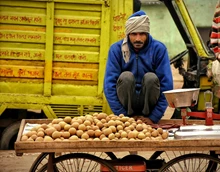
The Ongole breed, like other cattle breeds in India, gets its name from the region where it is bred. It is also known as the Nellore breed since Ongole Taluk, a division of a district, was previously part of the Nellore district but is now part of the Guntur district. It is now a part of Andhra Pradesh.
The breed's breeding tract spans across Andhra Pradesh's East Godavari, Guntur, Ongole, Nellore, and Kurnool districts, as well as the coast from Nellore to Vizianagram. Hardiness, disease resistance, and the ability to thrive on little food are all traits associated with the breed. Ongole cattle were widely exported to the United States for beef production, Brazil for beef and milk production, Sri Lanka, Fiji, and Jamaica for draught, Australia for heat tolerance and beef, and Switzerland for disease resistance.
Physical Characteristics of Ongole Cattle
The coat of this breed is shiny white. Dark markings on the head, neck, and hump, as well as black spots on the knees and pastern, distinguish males. Short and stumpy horns develop outward and backward from the poll's outer angles, thick at the base and without cracks. Cows have thinner horns than bulls. Cows have horns that stretch forth, upward, and inward. The regal walk, stumpy horns, and wide fan-shaped and plump dewlap define this breed. With an average lactation weight of 798 kg and a fat proportion of 3.79 percent, the breed produces a moderate amount of milk.
In their native land, Ongole cattle are effectively used for both work and milk production. They are normally docile, and the bulls are highly powerful, making them ideal for heavy plowing or vehicle work, but not for quick work or trotting.
Special Features of Ongole Cattle
-
A single Ongole bull weighs around 460 kilograms.
-
It can produce up to 2700 kg of milk. It has a 280-day lactation period.
-
Ongole breed cattle's milk is thought to contain 4-5 percent butterfat, resulting in well-nourished calves.
-
In times of great scarcity, Ongole breed cattle can slow down their metabolism to prevent starvation.
-
It can withstand higher temperatures. It can also make the most of crude protein.
-
This breed spends more time grazing than other breeds. They only take a break for 4% of the time they are grazing.
Disease Resistance in Ongole Breed Cattle
-
The immunity of the Ongole breed is well known.
-
It has a high level of resistance to eye cancer.
-
This breed is most recognized for its resistance to mad cow disease, which is common in other cattle breeds.
Feeding Behaviour of Ongole Breed Cattle
-
Cattle of the Ongole breed can be fed grain, crops, or crop residues such as sorghum, Zea mays, crotalaria, Macrotyloma, and fodder trees such as acacia, Azadirachta, and fiscus.
-
The fodder grasses andropogan, iseilema, and indigofera grasses species that were naturally growing on river and rivulets banks, private grazing grounds, and common grazing lands have sustained this breed for ages.











